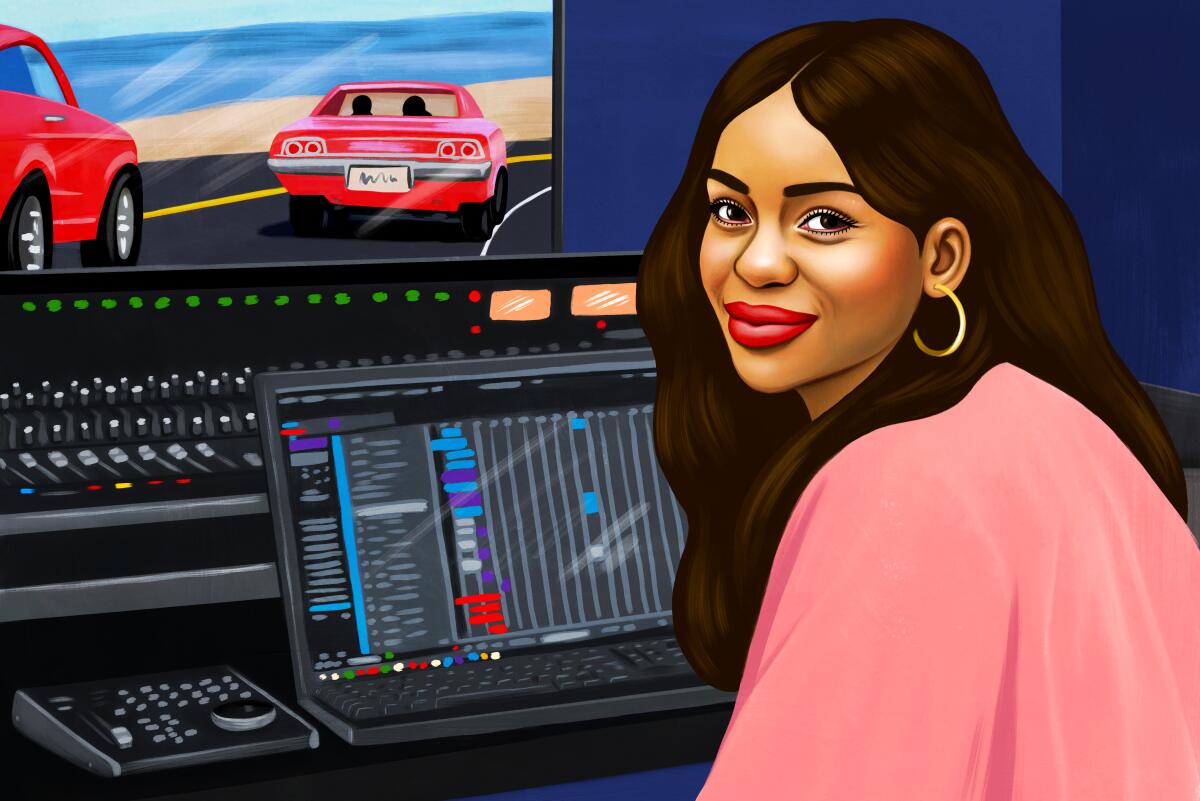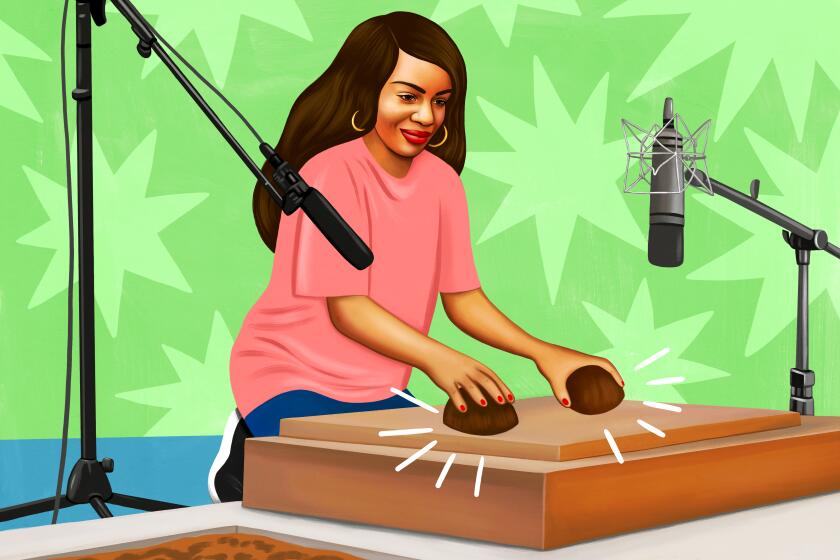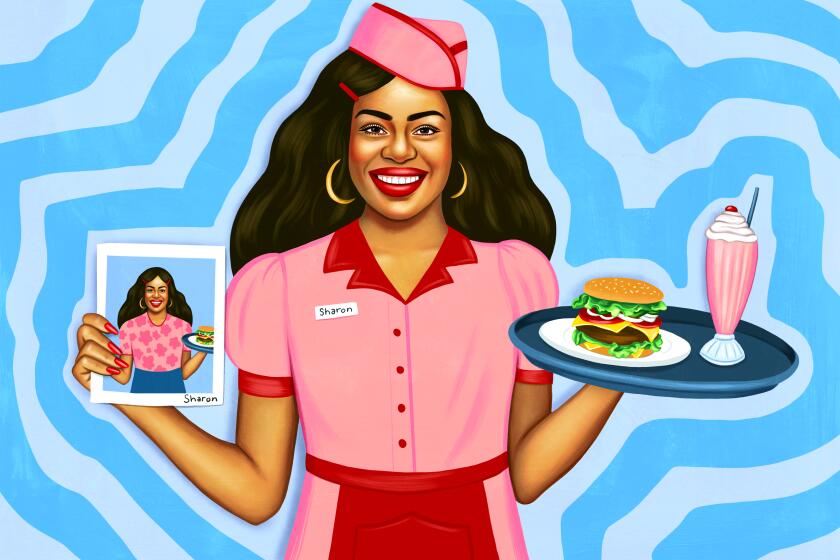Explaining Hollywood: How to get a job in sound design

- Share via
We call filmmakers “visionary” when they bring wondrous, strange or frightening worlds to life. But vision is just half the equation. To be truly immersive and transporting, a film or television show needs to have sound that matches its imagery and advances its story.
Chances are, most of the sound you hear in the theater or through your TV speakers wasn’t recorded when the scenes were shot on set. Instead, it was done by audio specialists after the filming wrapped up. The music, dialogue and sound effects are typically handled by different teams, although on low-budget productions a few people may do it all. The production’s composer oversees the music, and the rest is overseen by the supervising sound editor.
The sound effects team includes the people who clean up, enhance or replace the sounds recorded while the cameras rolled. They record sounds in the field, pull them from effects libraries and create them from scratch, then edit them to fit the narrative (and satisfy the director).
The person in charge of assembling that sonic palette is called the sound designer.
Increasingly, the demand for sound designers is coming from technology and video game companies, not just filmmakers. Which is not to say that you should abandon your dream of crafting medieval battle sounds for the big screen and aim instead to design the warning tone your car makes when you leave the lights on after parking. It’s just to note that the world of sound effects and sound design is evolving.
To find out what it takes to become a sound designer, The Times talked to award-winning veteran sound designers and supervising sound editors as well as some relative newcomers to the field, including James Lucero of Margarita Mix in Hollywood; Randy Thom and David Acord of Skywalker Sound in Marin; Vanessa Flores of Banana Post in Burbank; Cory Choy of Silver Sound in New York City; Maddie Bautista, a freelancer in Toronto; and Michele Darling, assistant chair of electronic production and design at Berklee College of Music in Boston. Here are their tips for getting started.
Who becomes a sound designer?
Simply put, it’s someone who wants to tell stories through sound, Darling said. A common feature is a background in music, with or without formal training — Darling, for example, was an electronic musician before she became a sound designer, and Bautista was a classically trained pianist, while Lucero and Acord were in bar bands.
For Lucero, the allure of music wasn’t just the songs, it was the distinctive sounds of the instruments — the tone of the guitar, the snap of the snare. “I really get into sounds, and I always have,” he said.
“When you’re playing music, you are honing your ears. You’re listening to all the different instruments, you’re listening to the notes played so you can play along,” he added. “Everything in sound is ear training in the end.”
It almost goes without saying that the job requires an ear for detail, an ability to peel apart the layers of a complex sound. That’s something you can develop with practice and experience, the pros say. But good sound design requires more than just the ability to re-create the creak of a door hinge or the bustle and clatter of a lunch counter. It’s also finding a way to elicit the emotional response that a scene demands.
“One of the first things you have to teach yourself as a sound designer is to forget about the literal,” Thom said. For example, he said, when you’re being asked by the director to come up with the sound for a gangster’s car, the most important information is not what kind of car it is. It’s who the gangster is, what kind of person he is and how he wants to be perceived.
So if the car is a souped-up Ford Mustang, Thom said, you could certainly start with a recording of an actual souped-up Mustang. A good sound designer then asks what can be layered into that sound that will be credible but also convey the essence of the character — say, that he’s wild and out of control.
“You start thinking about tigers roaring, and lions, and maybe even heavy surf,” Thom said, adding, “What you learn fairly soon is that the audience’s ear is amazingly pliable, in terms of what they will be willing to accept as truth. You have way more license than you think you do to play with sounds and stylize them and use unexpected elements to impart something emotional to them.”
That’s why sound designers tend to be creative, imaginative people, not just technicians — or, as Bautista put it, people who have “a very experimental mind that’s willing to problem solve.”
At the same time, there is a technical side to the job. Successful designers have a solid grounding in how sound is generated and shaped, the frequency ranges that different sounds occupy and other fundamentals of the science.
They also tend to be technologically adept. It’s de rigueur to be familiar with, if not an expert at, the digital audio workstation software the industry uses as well as the virtual instruments and effects that plug into it. And not only is the technology continually evolving, the software used for Hollywood productions (where Avid’s ProTools rules) is different from the programs used for video games, the theater and other applications.
One paradoxical thing about sound designers is that they like to spend hours perfecting a single sound by their lonesome, yet they’re also team players. That’s because they’re supporting someone else’s vision — typically, the director’s — and not their own. “You have to be able to throw it all away and go in a different direction” when a director doesn’t like a sound, Lucero said. “You can’t have an ego.”
Not only did the sound team behind ‘Greyhound’ have to re-create battle sequences, but they also had to make everything sound as if it were taken from the 1940s
How do you get started?
The route in depends on the type of sound design you want to do, whether it be for film and TV, for theater, for video games or for tech companies. But two common prerequisites are perseverance and serendipity.
When asked what it takes to get started, Acord said, “Nobody likes to hear this but it’s a lot of luck.” Raised in rural Delaware with no industry connections, his break came when he landed an unpaid internship in Philadelphia in the art department of the movie “12 Monkeys.” He eventually parlayed that into a series of paying gigs on the set, striking up a friendship with the production sound team, who took him on as a technician on their next job. That led to seven years of work in production sound. “Luck can certainly help get that foot in the door,” Acord added, “but it’s your skill that keeps you there.”
After moving to San Francisco with his wife in 1999, Acord decided to try to shift into postproduction, which meant having to make connections all over again. That bore fruit in 2001 when an acquaintance tipped him off about an apprenticeship at Skywalker Sound on “Star Wars: Episode II — Attack of the Clones.” He’s worked in postproduction sound ever since, most recently serving as sound designer and supervising sound editor on “The Suicide Squad” and the Lucasfilm TV series “The Mandalorian.”
It’s easier to make connections now in the era of social media, although getting established in postproduction sound still can be a challenge.
Take Flores, for instance. After earning an associate degree in film studies from Riverside Community College in 2015 and a certificate in audio engineering with postproduction audio from Musicians Institute in Hollywood in 2016, she said she was left asking, “Now what? Where’s the jobs?”
She eventually took a weekend shift at a warehouse to support herself while she did freelance sound editing and design, reaching out to and networking with as many filmmakers as she could. In a field dominated by white men, Flores said, “I knew I had to stand out from the pack and not give anybody a reason to doubt what I could bring to the table.”
She got leads and tips from mentoring sites such as SoundGirls.org and People of Color in Audio, and as she did more work on low-budget independent products, she built up her presence on Instagram and other social media networks. “I got so many referrals because I was out there,” Flores said.
Last June she landed a full-time job as a sound editor at Banana Post in Burbank, which handles the postproduction sound for a number of unscripted TV shows. Flores credits her boss, Chad Mumford, with giving opportunities to people like her who are underrepresented in the field. Now she posts job openings and offers free how-to videos online for would-be sound designers.
Increasingly, people train for a career in postproduction sound at a film school or other specialized program, as Flores did. But training is just the table stakes. You’ll still need to develop a body of work to show prospective employers and clients, possibly by tracking down some student filmmakers and volunteering to do sound for them. Another way to find opportunities is to scour the postings at sites such as StaffMeUp, Mandy and even Craigslist.
Happily, the technology for recording and shaping sound is far cheaper and more accessible than it used to be, so it’s a lot easier to dive in. “There are a million inexpensive and powerful tools available,” Choy said. “Two of my favorites are Reaper, which I use professionally, and Audacity, which is free.”
Two other suggestions from Flores: Try to land a job helping out with sound on a set, as Acord did, which will familiarize you with many aspects of the filmmaking process.
And instead of running errands as an intern, ask sound professionals to let you watch them work for a day. “You’ll be surprised people who will let you shadow them,” she said, adding, “You’re going to learn so much from that.”
Thom, who got his start as an apprentice working for fabled editor/sound designer Walter Murch on “Apocalypse Now,” said apprenticeships used to be the standard way to get started. They’re not as common these days, he said, but the experience is still invaluable.
“Because no matter how good a film school you go to or how good a sound course you take, it’s not going to be a perfect simulation of working in the real-world movie business,” Thom said.
It’s a very tough field to succeed in, and connections are vital to getting started. Having a background in music and dance helps.
What are the career paths?
There’s no one route to becoming a sound designer. Oftentimes, people will start by handling multiple other sound jobs on smaller productions. For example, Lucero had just started working at a postproduction studio in New York when it was hired to do the sound for a new animated series for children, “Dora the Explorer.” Over the course of 34 episodes, Lucero says, he handled duties as a dialogue editor, a sound effects editor and a music editor.
The skills involved are different, though; editing dialogue is nothing like performing as a foley artist or mixing sound. So on productions with larger budgets, the tasks tend to be split among people who focus on each of those specialties. Still, some sound designers say that it’s good to get experience at all of these jobs. And as a practical matter, the more sound tasks you can handle, the greater your chances are of finding work.
You don’t have to work your way up the ladder in Hollywood to have a career in sound design. There are many opportunities for sound work outside of film and television. Bautista is a good example: She plies her skills for theater productions in Canada, where she also works as a composer.
So is Choy. Although he has a long list of film and TV credits, Choy said he does sound for “everything” — movies, video games, virtual reality apps, fine-art installations, television shows, podcasts. “One of the reasons I like being in New York,” he said, is that “I have the opportunity to work on a wide range of things with a wide range of clients, and I’m not working on only one sort of thing.”
Supervising sound editor Nicolas Becker takes viewers on an aural journey that leaves us feeling what it’s like to lose our hearing.
How do you make money? (And what kind of money?)
There are postproduction studios that offer full-time jobs to sound designers, but the work typically is project-based. And if the project is a film or TV show, chances are that the jobs will be done by union labor — sound workers are represented by the International Alliance of Theatrical Stage Employees — at union rates. Depending on the production’s budget and location, the weekly rates for sound editors range from about $1,600 to nearly $2,700.
On nonunion work, the rates are up for negotiation. Fledgling sound designers are in a tough spot: They need to do as much work as they can to establish their reputation and hone their skills, but they also have to pay the rent. Flores recommends the freelance rate calculator from Sheetlist, a free Google spreadsheet that helps you figure out how much you need to charge for the different jobs you’re performing in order to stay afloat.
How is this career different than it was 10 or 25 years ago?
The biggest change in postproduction sound happened when digital technology replaced analog tape and tube-based equipment, a process that was in full swing by the late 1980s and early ‘90s. That made the tools for creating, recording, editing and mixing sounds far more accessible and affordable.
Today, Choy said, “To do some just amazing things with sound, you don’t need some crazy expensive set-up.” He added, “Operations or moves that used to either be impossible or take me literal hours to do can now be accomplished in a matter of seconds.”
The most dramatic difference in the career nowadays is on the demand side. Video game studios have become a major new source of work for sound designers and, increasingly, other tech companies have as well.
Darling said that most of the sound design work she’s doing now is creating preset sounds for music tech companies. Her Berklee colleague Dustin Gee, director of the college’s career programs, said students are finding lots of work in video games and in user interaction sound design, designing sounds for app developers, social media platforms and even car companies.
For a glimpse of the variety of jobs available for audio professionals, go to Soundlister.com.
For many people who pursue entertainment as a career, it takes years to get yourself to where you are making money from your creative work. For making money in the meantime, there’s always waiting tables. But more and more people are turning to platforms like TikTok, Twitch and Patreon.
What do people get wrong about sound design?
The biggest mistake people make about this field, Thom said, is “thinking that sound is a technical job. It’s just not true. It’s mostly an aesthetic job.”
In fact, he said, one reason Murch and Ben Burtt, another leading supervising sound editor, started calling themselves sound designers in the 1970s was to push back against the notion that they were just technicians who spent their days dumping other people’s work onto the cutting-room floor.
“I like to think more often that we discover sounds,” Thom said, fitting pieces of what they’ve experienced together into something new that serves the story.
Choy said it’s a myth that someone who designs sounds is some sort of wizard, or that the craft is something “exclusive to a tribe or a mage.” Instead, he said, “A sound engineer pays special attention to sounds and the way they relate to each other, and you can learn to do that.”
He also pushed back on the argument that you have to master ProTools or other specific programs to make it in the industry, noting that new options are continually emerging as the technology evolves. “Today’s tools are so powerful and accessible that it’s really about the creator, not the vehicle. ‘Industry standard’ is not immovable and shifts with time and technology,” he said.
Rejection and uncertainty are part of working in Hollywood, but joy, creativity and fun can be too. Here’s how to manage your mental health.
What’s some good advice?
Listen to the world around you. Acord said he carries a recorder with him just about everywhere. “Sometimes I’ll just hear in the wild a particular sound and think, ‘I need to grab that.’ I don’t know what I’m going to use it for, or when I’m going to use it.” The point, he said, is to recognize the potential in the sounds you stumble across, and “build this creative palette that you’re going to lean on.”
Get better by examining the work of other sound designers. Lucero said when he was just starting out, he would “deconstruct other people’s work during off hours,” looking at their techniques and the sounds they used. “It was a tremendous amount of practicing.”
Have a presence online in the spaces where your prospective clients are. For example, Flores said, if you want to work on commercials, you have to find where the directors or producers who are making commercials live on social media and build relationships with them there.
Pay attention to the business side of your craft. This is particularly important if you do sound design as a freelancer, Darling said. You’ll need to understand how to get the word out about yourself, how to send invoices and pay taxes, and how to make ends meet when jobs are temporary and payment is delayed. She added, “I always tell students, if you’re going to freelance and the work is not steady or full-time, try to have four clients so you can have more opportunities for consistent work.”
Read more of The Times’ guide to working in Hollywood.
More to Read
Inside the business of entertainment
The Wide Shot brings you news, analysis and insights on everything from streaming wars to production — and what it all means for the future.
You may occasionally receive promotional content from the Los Angeles Times.














